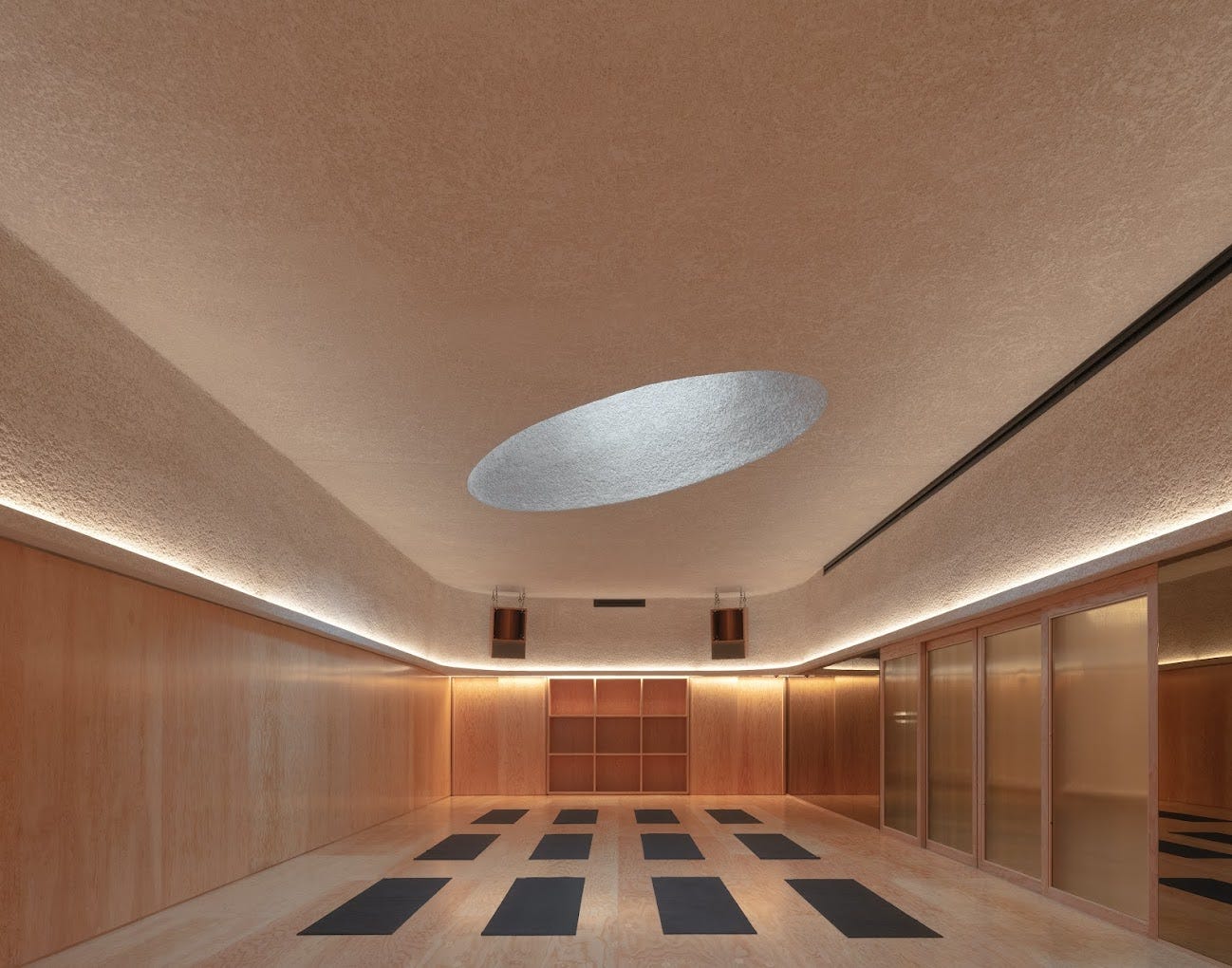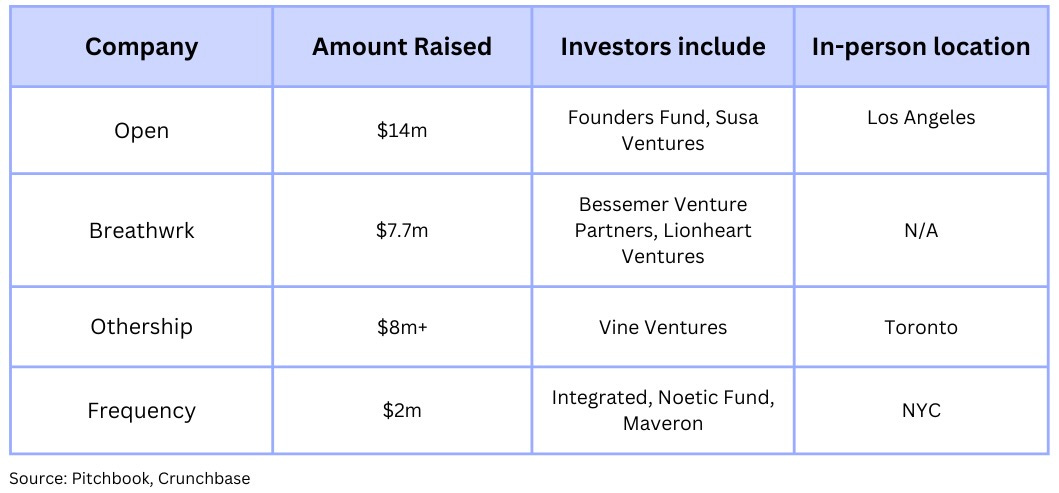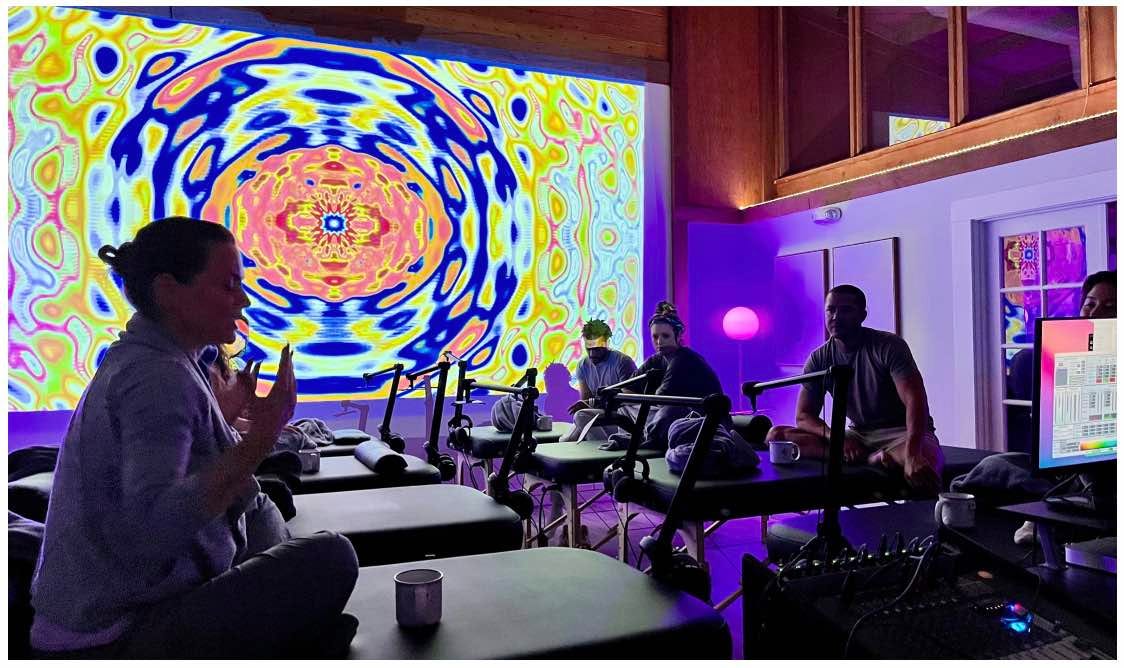The Startup Landscape for Expanding Consciousness
An overview of the venture backed startup ecosystem focus on expanding consciousness
This post was a collaboration with my friend Greg Kubin from PsyMed Ventures. We both share a deep interest in the intersection of technology and the expansion of consciousness. We teamed up to to create this primer that outlines the venture backed startup ecosystem at this intersection. We also recorded this conversation on the topic which goes a bit deeper. Enjoy!
Altered states of consciousness are going mainstream.
Once accessible only through indigenous psychedelic ceremonies or 10-day silent vipassana retreats, changes in technology, regulation, and attitudes are ushering in a golden age of consciousness.
Startups will play a key role in enabling and expanding access to altered states of consciousness. The types of companies come in many flavors – hardware, software, and community. Technology could even result in accessing completely new states of consciousness.
But first… how do we define consciousness?
Most humans live in a state of normal waking consciousness – i.e. being aware of your thoughts, feelings, and physical surroundings. For most people, this is seemingly all there is to reality, maybe with the exception of dreams. In contrast, altered (or “alternative”) states of consciousness enable us to experience additional levels of awareness, perceptions, memories, thinking, emotions, sense of time, place, and self-control (source). In the process, they expand our understanding of the potentials of reality and the human experience. There are a variety of reasons people seek altered states: improved mental health, physical healing, creative breakthroughs, & spiritual connectedness. There are also risks – altered states can be destabilizing without proper support.
“Our normal waking consciousness . . . is but one special type of consciousness, whilst all about it, parted from it by the flimsiest of screens, there lie potential forms of consciousness entirely different. We may go through life without suspecting their existence; but apply the requisite stimulus and at a touch they are all there in all their completeness”
- William James, The Varieties of Religious Experience
Today, both modern and ancient techniques to reliably catalyze these experiences are gaining in popularity. In this article, we explore 7 categories of consciousness startups: psychedelics, breathwork, meditation, dreams, prayer, & light & sound. We also predict which business models are most promising and which may have challenges to achieving scale.
Note: We included categories where we see meaningful traction and/or venture-backable business models that can use external technology that expand access to expanded states.
We excluded domains where we don’t yet see meaningful startup activity (e.g. yoga, working with a spiritual teacher).
Psychedelics
Humans have taken psychedelics to catalyze altered states of consciousness for millennia.
Psilocybin has been used as a sacrament & healing medicine by Mesoamericans for 3500 years and ayahuasca for 1,000 years in South America. Synthetic compounds like ketamine are a 20th-century phenomenon through modern drug development.
Today, there’s over 100 startups commercializing psychedelics. Many companies are pursuing FDA approval for mental illness: MAPS is in Phase 3 for MDMA-assisted therapy for PTSD, Compass Pathways is in Phase 2b for Psilocybin for Treatment-Resistant Depression. Companies like Mindstate Design Labs are developing compounds that more reliably induce mystical states. Mindbloom has become the largest ketamine assisted therapy provider for anxiety and depression in the United States.
What’s the connection between altered states and mental health? An NYU study in 2016 for patients with cancer-related psychological distress found that “the psilocybin-induced mystical experience mediated the therapeutic effect of psilocybin on anxiety and depression”. In other words, the more mystical the experience, the more therapeutic for many patients.
Yet it’s important to note that while some believe the hallucination (an altered state) is important for therapeutic benefit, other startups like Delix Therapeutics are developing non-hallucinogenic analogs of psychedelic compounds that may still be therapeutic by inducing neuroplasticity – the brain’s ability to regrow and reform lost connections.
We believe the business models with the biggest outcomes will be:
drug development (with shorter duration treatments with some or no psychotherapy, depending on the compound)
infrastructure (providing telehealth services or software/services to clinics and clinicians)
marketplaces for finding treatments
Meanwhile, we believe clinics will be an important part of the ecosystem as sites for care delivery, but are less aligned with venture capital.
Psychedelic companies who have raised $50m+:
To follow psychedelic startup news, check out resources like Psychedelic Alpha, The Trip Report by Beckley Waves Lucis News, and Business Trip (a podcast hosted by Greg and Matias at PsyMed Ventures).
Meditation
The first wave of meditation apps like Headspace and Calm showed that there’s millions of meditators looking for a daily practice. They are each reportedly valued over $1bn. Additional companies in the space like Ten Percent are generating 8 figures in revenue. These apps were many people’s first entry point into meditation. In the absence of a convenient app on their phone, they may have never found a practice that worked for them or coincided with their lifestyle.
Today, entrepreneurs are finding ways to enhance these ancient practices by building hardware to make meditative states more accessible or profound. Muse’s EEG headband uses real-time audio and neurofeedback to guide users while meditating.
Taking it a step further, a new company called Jhourney is developing a closed loop neurofeedback device intended to guide users into jhanas. Jhana is an altered state of consciousness that can be accessed through deep meditation. There’s 9 jhanas; Buddha apparently reached the 8th jhana to reach enlightenment. In modern scientific terms, “jhanas are Altered States of Consciousness that imply major brain changes based on subjective reports: (1) external awareness dims, (2) internal verbalizations fade, (3) the sense of personal boundaries is altered, (4) attention is highly focused on the object of meditation, and (5) joy increases to high levels.” (Hagerty et al 2013). Jhourney has been studying brainwave activity from advanced meditators to productize the experience.
Other companies such as Sensate and NeuvanaLife have created hardware devices that use sonic resonance to stimulate the vagus nerve and calm your body's nervous system to enhance the meditation experience. While they are not meditation devices, they do accelerate one’s sense of relaxation and depth of practice.
Given the success of Calm and Headspace, we already know that meditation is a huge market with plenty of room to go. It remains to be seen if the hardware devices are technically viable, but we believe that if they do work as planned, they represent a meaningful opportunity to expand the market and make expanded states more accessible to people who prefer to abstain from substances like psychedelics.
Breathwork
There is a vast range of Breathwork practices from Pranayama to Holotropic.
Pranayama is a yogic breathing practice. “Prana” means “life force energy” and “yama” means “breathe” in Sanskrit.
Holotropic breathwork was developed by Stan Grof in the 1960s after LSD and psychedelic therapy research was outlawed. It involves rapid breathing or hyperventilating for periods up to 3 hours. Scientific studies on breathwork demonstrate enhanced mood, and there are also many reports of people leaving their body, accessing unconscious memories, or just experiencing a still mind.
Apps like Othership and Breathwrk offer on-demand, guided breathwork experiences inspired by these practices. Othership also operates bathhouses with live breathwork. Open has in-person and digital classes for breathwork, in addition to meditation and full-body workouts. Frequency offers virtual breathwork classes and in-person classes that project DMT-inspired imagery on the ceiling.
Open - Los Angeles
Frequency - NYC
Othership - Toronto
Will breathwork startups achieve venture scale? If we look to meditation as a precedent, there’s certainly a chance for apps to succeed in this space.
One thing many of these startups seem to have cued in on is the importance of community. It may be why both Othership, Frequency and now Open (which was originally digital first) are opening retail locations.
Although breathwork is much easier for a lot of people than quieting the mind through meditation, it also requires a bit more dedicated time & space relative to closing your eyes and tuning in anywhere. Trauma, somatic, and emotional healing literacy is on the rise, to which breath proves to be a powerful intervention.
We think it’s fair to say that the breathwork and meditation will help grow each market respectively, as both practices can complement each other, providing a slightly different experience.
Breathwork startups landing VC dollars:
Dreamwork
Dreams access our subconscious, an altered state of consciousness that most people are familiar with. Today, the dream experience for most people is random and lacks agency.
Lucid dreams occur when you’re aware that you’re dreaming which can create a state of control atypical to normal dreams. In the past, most people learned to induce lucid dreams by writing down their dreams and training themselves to recognize whether they are dreaming or not. A few startups such as Shape, Lucidity, and Oniri help dreamers track their dreams to help make these practices easier. Oniri has a dream analysis tool that uses AI to interpret your entries.
The new kid on the block is Prophetic.ai who have created a headband called The Halo – it intends to make it easier to induce and stabilize lucid dreams. Prophetic isn’t the first company who has attempted to use hardware to make lucid dreaming more accessible. Products such as LucidDreamer and Remee have come out with their own unique products to help dreamers more reliably experience this phenomenon. Remee uses customizable light patterns that your dreaming mind can recognize. It’s still early days in the development of these technologies, so the efficacy and repeatability isn’t validated yet. We can only dream about it…
It’s hard to predict how big of a market lucid dreaming will be. It's a recreational and not a medical market, so there isn’t a clear pathway for reimbursement. Perhaps the lucid dream device, if it works, will be a fun toy for Freudian and Jungian enthusiasts. Yet as Chris Dixon once said, the next big thing will start out looking like a toy…
*None of the startups in the dreaming space that we were able to find announced significant funding as of writing this.
Prayer
For many, prayer is the OG way of connecting to a higher power. Similar to meditation, some forms of prayer can induce altered states of consciousness which have been cited across history. The 14th century Christian mystic Julian of Norwich once wrote, “The fruit and the purpose of prayer is to be 'oned' with and like God in all things.”
Now in the 21st Century, Hallow and Pray.com are Christian prayer apps that have amassed huge followings as well as celebrity investors. Hallow has raised $105m from investors including Homebrew, Susa Ventures, General Catalyst and Mark Wahlberg. Pray.com has raised $34m from investors including Founders Fund, Kleiner Perkins, Greylock, and Diplo. Worth noting that Peter Thiel is an investor in both companies.
Mark Walhberg, an investor in Hallow, promoting his latest film Father Stu in the app.
This market is already taking off due to the large Christian population in the US. COVID probably also helped boost user #’s.
One question we’re asking is: how can this be applied to other faiths?
Sound
The use of sound to induce altered states also has ancient roots. It has been documented across many cultures how rhythmic drumming and chanting over long periods of time can help people access more expansive states of consciousness.
A growing number of startups are looking to use modern technology to replicate these types of cymatic experiences. Opus officially launched their $2,499 soundbed this year which uses vibration and a companion soundscape application to port people into deep inner experiences. It promises to “make you feel better in as little as 7 minutes.” Tune Bed is another vibroaccoustic bed that is designed to relax the nervous system in fifteen minutes. The $8,999 bed (and $39 monthly subscription) is marketed for at home use, in wellness studios, and within office as an employee work perk. Meanwhile companies like Endel, Brain.fm, and Nucalm, have created sophisticated and personalized soundscapes that entrain your brain and nervous system into more relaxed & focused states of being.
Opus sounbed
One of the compelling parts about the sound market is how easy compliance is. How many people have you heard try meditation “but just can’t do it.” Well, it seems like anyone can sit there and listen to something to feel better.
Personalized soundscapes are highly scalable but less defensible. There’s also the question of how much a difference does personalization really make?
Hardware/software is a tough business, but if companies like Opus can deliver on the experience it could be a very compelling business quickly. The high ticket price of Opus ($2.5k) means it only needs to sell 40,000 units to reach $100m of revenue and there are clear paths to subscription revenue through companion applications.
Light/Visual Perception
An emerging modality to create altered states are companies focused on leveraging light and visual perception enhancements like virtual reality environments.
Companies like NeuroVizr use light and sound to increase neuroplasticity while products like Lucia N*03 uses flickering light to stimulate the optic nerve and central brain to help users access deep states. Lumenate is an iPhone app that flashes the flashlight on closed eyes, resulting in kaleidoscopic shapes and subconscious exploration. Reality Labs induces altered states through light, sound, and a vibrating water bed.
Reality Labs - Los Angeles
NeuroVizr
Virtual reality has the huge potential to create or assist in altered state experiences. Products like Psyrreal simulates the subjective effects and phenomenological components of psychedelic experiences without any substances, showing promising results for reducing depressive symptoms. While other companies like Tripp and Enosis Therapeutics see VR as a way to enhance existing mindfulness or therapeutic practices.
In the VR side of things, Tripp is the biggest player in the space so far, having raised over $26m. The breakouts in VR have been multiplayer platforms like RecRoom ($1bn valuation, Sequoia backed). Tripp’s acquisition of EvolVR (group yoga and meditation) is a step in that direction.
While most of the activity we’re seeing is commercial, the clinical route is a viable model for light, visual, and sound companies. For example, Cognito Therapeutics is a wearable that transmits gamma frequency light and sound. While the device doesn’t induce an altered state, it does reduce neurodegeneration and improve cognitive function. They’ve raised over $100m.
What’s next?
If you’re still reading this and haven’t closed your computer to drop into an altered state, thanks for sticking around.
It truly feels like we’re at the beginning of a new era of consciousness exploration. There are even folks like DMTx that aim to create a map for alternate dimensions through extended DMT experiences. Perhaps the Tibetan book of the dead will become an accessible reality to the living in our lifetimes!
While we listed domains that are currently heating up for startups, we’re keeping our eyes on other consciousness-related spaces that could be part of the next wave of breakout spaces. These include hypnosis (e.g. Reverie), past life regression, body practices, and brain computer interfaces. A major category that has little venture startup activity worth calling out is the transformation of subconscious beliefs and emotions. This category includes everything from teacher, personality, and practitioner driven businesses (i.e. Joe Dispenza, Gabor Mate, etc.), to method based approaches (i.e. Internal Family Systems, TRE, etc).
One thing that will inevitably come up as this consciousness industry grows is the role of money as it relates to achieving spiritual growth. Will the early pioneers and stewards of these technologies get to participate in the wealth creation and be a stakeholder? We’re already starting to see lots of debate in categories like psychedelics amongst members of the indigenous healing community. Ultimately, change happens at the speed of trust.
Right now at least, it seems like many of these technologies can be viewed as valuable exposure mechanisms to motivate the conscious seeker or serve as a timely tool on one’s healing journey. When you touch these altered states, inevitably the task becomes doing the inner work required to integrate these experience and eventually stabilize deeper levels of awareness. In the words of Ram Dass:
“These medicines [psychedelics] will allow you to come and visit Christ, but you can only stay two hours. Then you have to leave again. This is not the true samadhi. It’s better to become Christ than to visit him – but even the visit of a saint for a moment is useful”
Greg I recorded a deeper conversation on this topic about our outstanding questions, opportunities we’re excited about, and predictions of how things might unfold. You can check that chat out here.
If you’re building a company expanding access to altered states of consciousness, please feel free to reach out Greg or myself. We are always interested in hearing other ideas on ways to collaborate!
If you liked this post, feel free to click the ❤️ or 🔄 button on this post so more people can discover it on Substack 🙏


















Dang, this is comprehensive and a wonderful resource. Thanks for putting this together Scott! I hope you keep it updated ;)
Very comprehensive indeed. Love these observations.